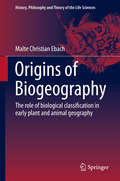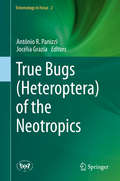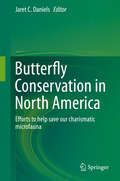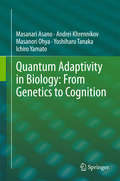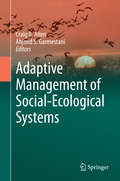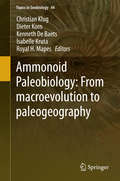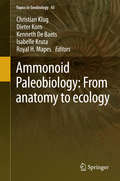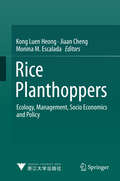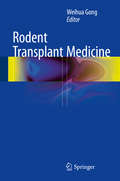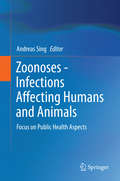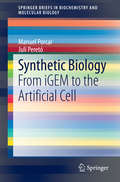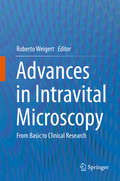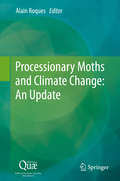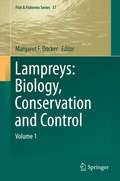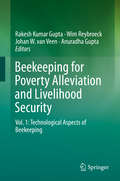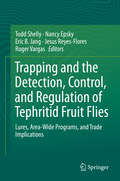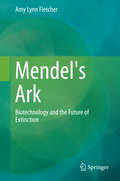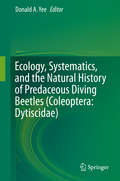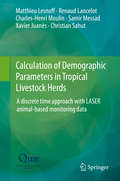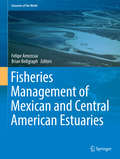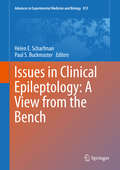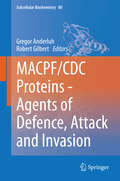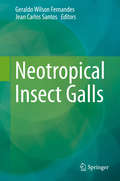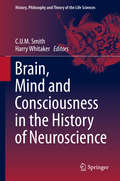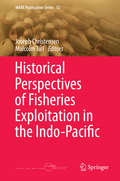- Table View
- List View
Origins of Biogeography: The role of biological classification in early plant and animal geography (History, Philosophy and Theory of the Life Sciences #13)
by Malte Christian EbachThis book presents a revised history of early biogeography and investigates the split in taxonomic practice, between the classification of taxa and the classification of vegetation. It moves beyond the traditional belief that biogeography is born from a synthesis of Darwin and Wallace and focuses on the important pioneering work of earlier practitioners such as Zimmermann, Stromeyer, de Candolle and Humboldt.Tracing the academic history of biogeography over the decades and centuries, this book recounts the early schisms in phyto and zoogeography, the shedding of its bonds to taxonomy, its adoption of an ecological framework and its beginnings at the dawn of the 20th century. This book assesses the contributions of key figures such as Zimmermann, Humboldt and Wallace and reminds us of the forgotten influence of plant and animal geographers including Stromeyer, Prichard and de Candolle, whose early attempts at classifying animal and plant geography would inform later progress.The Origins of Biogeography is a science historiography aimed at biogeographers, who have little access to a detailed history of the practices of early plant and animal geographers. This book will also reveal how biological classification has shaped 18th and 19th century plant and animal geography and why it is relevant to the 21st bio geographer.
True Bugs (Entomology in Focus #2)
by Antônio R. Panizzi Jocélia GraziaTrue bugs (Heteroptera) are a diverse and complex group of plant-feeding and predatory insects important to food production, human health, the global economy and the environment. Within the nearly 43,000 species described around the world, Neotropical true bugs are particularly diverse, and much remains to be discovered about their biology and relations with other species. Inspired by the need for a comprehensive assessment, True Bugs (Heteroptera) of the Neotropics is the most complete and thorough review ever published.Experts in each of the seven infraorders have drawn together the scattered literature to provide detailed treatments of each major taxon. The most common and important species as well as select lesser known species in each major family are covered, highlighting morphology, classification, biology and ecology. The numerous color illustrations highlight key species and their adaptations, and importance to basic and applied sciences is discussed.Each chapter is based on an up-to-date review of the literature, and with a bibliography of more than 3,000 references, readers are presented with an unprecedented and vital and timely account of the true bugs of the Neotropical Region.
Butterfly Conservation in North America: Efforts to help save our charismatic microfauna
by Jaret C. DanielsThe book addresses this critical need by providing a straightforward and easy to read primer to key elements of at-risk butterfly conservation programs including captive husbandry, organism reintroduction, habitat restoration, population monitoring, recovery planning and cooperative programs.Impacts from habitat loss and fragmentation, invasive species, and climate change continue to accelerate the rate of imperilment and necessitate increased conservation action.Zoos, natural history museums, botanical gardens and wildlife agencies are progressively focusing on insects, particularly charismatic groups such as butterflies and native pollinators, to help advance local conservation efforts and foster increased community interest and engagement.Today, many institutions and their partners have successfully initiated at-risk butterfly conservation programs, and numerous others are exploring ways to become involved. However, insufficient experience and familiarity with insects is a critical constraint preventing staff and institutions from adequately planning, implementing and evaluating organism-targeted activities.The information provided is intended to improve staff practices, learn from existing programs, promote broader information exchange, and strengthen institutional ability to develop new or improve existing butterfly conservation initiatives.The information provided is intended to improve staff practices, learn from existing programs, promote broader information exchange, and strengthen institutional ability to develop new or improve existing butterfly conservation initiatives.This book will be useful to professionals from zoos, natural history museums, botanical gardens, wildlife agencies, conservation organizations, land managers, students, and scientist in conservation biology, ecology, entomology, biology, and zoology.
Quantum Adaptivity in Biology: From Genetics to Cognition
by Masanari Asano Andrei Khrennikov Masanori Ohya Yoshiharu Tanaka Ichiro YamatoThis book examines information processing performed by bio-systems at all scales: from genomes, cells and proteins to cognitive and even social systems. It introduces a theoretical/conceptual principle based on quantum information and non-Kolmogorov probability theory to explain information processing phenomena in biology as a whole.The book begins with an introduction followed by two chapters devoted to fundamentals, one covering classical and quantum probability, which also contains a brief introduction to quantum formalism, and another on an information approach to molecular biology, genetics and epigenetics. It then goes on to examine adaptive dynamics, including applications to biology, and non-Kolmogorov probability theory.Next, the book discusses the possibility to apply the quantum formalism to model biological evolution, especially at the cellular level: genetic and epigenetic evolutions. It also presents a model of the epigenetic cellular evolution based on the mathematical formalism of open quantum systems. The last two chapters of the book explore foundational problems of quantum mechanics and demonstrate the power of usage of positive operator valued measures (POVMs) in biological science.This book will appeal to a diverse group of readers including experts in biology, cognitive science, decision making, sociology, psychology, and physics; mathematicians working on problems of quantum probability and information and researchers in quantum foundations.
Adaptive Management of Social-Ecological Systems
by Craig R. Allen Ahjond S. GarmestaniAdaptive management is an approach to managing social-ecological systems that fosters learning about the systems being managed and remains at the forefront of environmental management nearly 40 years after its original conception. Adaptive management persists because it allows action despite uncertainty, and uncertainty is reduced when learning occurs during the management process. Often termed “learning by doing”, the allure of this management approach has entrenched the concept widely in agency direction and statutory mandates across the globe. This exceptional volume is a collection of essays on the past, present and future of adaptive management written by prominent authors with long experience in developing, implementing, and assessing adaptive management. Moving forward, the book provides policymakers, managers and scientists a powerful tool for managing for resilience in the face of uncertainty.
Ammonoid Paleobiology: From Macroevolution To Paleogeography (Topics in Geobiology #44)
by Christian Klug Dieter Korn Kenneth De Baets Isabelle Kruta Royal H. MapesThis two-volume work is a testament to the abiding interest and human fascination with ammonites. We offer a new model to explain the morphogenesis of septa and the shell, we explore their habitats by the content of stable isotopes in their shells, we discuss the origin and later evolution of this important clade, and we deliver hypotheses on its demise. The Ammonoidea produced a great number of species that can be used in biostratigraphy and possibly, this is the macrofossil group, which has been used the most for that purpose. Nevertheless, many aspects of their anatomy, mode of life, development or paleobiogeographic distribution are still poorly known. Themes treated are biostratigraphy, paleoecology, paleoenvironment, paleobiogeography, evolution, phylogeny, and ontogeny. Advances such as an explosion of new information about ammonites, new technologies such as isotopic analysis, tomography and virtual paleontology in general, as well as continuous discovery of new fossil finds have given us the opportunity to present a comprehensive and timely "state of the art" compilation. Moreover, it also points the way for future studies to further enhance our understanding of this endlessly fascinating group of organisms.
Ammonoid Paleobiology: From Anatomy To Ecology (Topics in Geobiology #43)
by Christian Klug Dieter Korn Kenneth De Baets Isabelle Kruta Royal H. MapesThis two-volume work is a testament to the abiding interest and human fascination with ammonites. We offer a new model to explain the morphogenesis of septa and the shell, we explore their habitats by the content of stable isotopes in their shells, we discuss the origin and later evolution of this important clade, and we deliver hypotheses on its demise. The Ammonoidea produced a great number of species that can be used in biostratigraphy and possibly, this is the macrofossil group, which has been used the most for that purpose. Nevertheless, many aspects of their anatomy, mode of life, development or paleobiogeographic distribution are still poorly known. Themes treated are biostratigraphy, paleoecology, paleoenvironment, paleobiogeography, evolution, phylogeny, and ontogeny. Advances such as an explosion of new information about ammonites, new technologies such as isotopic analysis, tomography and virtual paleontology in general, as well as continuous discovery of new fossil finds have given us the opportunity to present a comprehensive and timely "state of the art" compilation. Moreover, it also points the way for future studies to further enhance our understanding of this endlessly fascinating group of organisms.
Rice Planthoppers: Ecology, Management, Socio Economics and Policy
by Kong Luen Heong Jiaan Cheng Monina M. EscaladaThe book discusses planthopper pests of rice. These insects are one of the most destructive pests, threatening food security around the world. The historical development of the rice planthopper problem shows that they are secondary pests and single-discipline control tactics or strategies were not able to manage them, and instead caused frequent resurgences. This book not only presents new approaches to this persistent problem, but also new ecological methods, new perspectives on the effect of pesticide marketing, insights into developing resistant varieties and structural reforms in pest management. Integrating biological, ecological, economic and sociological aspects, it clearly presents the latest information on newly developed strategies for managing this pest.Dr. K. L. Heong is the principal scientist and insect ecologist at the International Rice Research Institute, Philippines. He has been researching rice planthoppers for more than 30 years. Dr. Heong is a fellow of the Third World Academy of Science and the Academy of Sciences, Malaysia.Professor Jia-an Cheng is an insect ecologist who has been studying rice planthoppers for about 50 years. He is a professor at Zhejiang University, China.Professor M.M. Escalada works at Visayas State University.
Rodent Transplant Medicine
by Weihua GongThis book introduces transplantation in rodents as useful tools used in studying transplant immunobiology. Several solid organs (kidney, heart, liver) transplant models in rodents are described in this book. It can help surgical quality and save surgical time. The first part of the book provides a review of rodent transplant tolerance induction, the role of gender and body-weight in rodent transplantation, surgical instruments and organ preservation solutions. In the second part of the book, various organ-transplantation techniques in rodents are discussed in individual chapters. This book presents uniform surgical procedures in mouse and rats, which produce comparable data, efficiently enhancing the translational research from bench to non-human primates and beyond. It will be of great value to transplant researchers, research fellows and clinicians in many surgical specialties.
Zoonoses - Infections Affecting Humans and Animals: Focus on Public Health Aspects
by Andreas SingThe book will cover the most important zoonoses with a public health impact and debate actual developments in this field from a One Health perspective. The outline of the book follows a “setting” approach, i.e. special settings of zoonoses with a public health aspect, rather than presenting a simple textbook of an encyclopedic character. Main chapters will deal with zoonoses in the food chain including a special focus on the emerging issue of antibiotic resistance, with zoonoses in domestic and pet animals, in wildlife animal species (including bats as an important infectious agent multiplier), influenza and tuberculosis as most prominent zoonoses, and zoonotic pathogens as bioterroristic agents. Special interest chapters debate non-resolved and currently hotly debated zoonoses (e.g. M. Crohn/paratuberculosis, chronic botulism) as well as the economic and ecological aspects of zoonoses.
Synthetic Biology: From iGEM to the Artificial Cell (SpringerBriefs in Biochemistry and Molecular Biology #12)
by Manuel Porcar Juli PeretóSynthetic Biology (SB) is a revolutionary discipline with a vast range of practical applications, but is SB research really based on engineering principles? Does it contributing to the artificial synthesis of life or does it utilise approaches sufficiently advanced to fall outside the scope of biotechnology or metabolic engineering? This volume reviews the development of SB and includes the major milestones of the discipline, the ‘top-down’ and ‘bottom-up’ approaches towards the construction of an artificial cell and the development of the “iGEM” competition. We conclude that SB is an emerging field with extraordinary technological potential, but that most research projects actually are an extension of metabolic engineering since the complexity of living organisms, their tight dependence on evolution and our limited knowledge of the interactions between the molecules, actually make life difficult to engineer.
Advances in Intravital Microscopy: From Basic to Clinical Research
by Roberto WeigertThis is the first book entirely dedicated to Intravital Microscopy. It provides the reader with a broad overview of the main applications of Intravital Microscopy in various areas of the biomedical field. The book contains accurate descriptions of the state of the art methodologies used to image various organs at different level of resolution, ranging from whole tissue down to sub-cellular structures. Moreover, it is an extremely valuable guide to scientists that want to adopt this powerful technique and do not have experience with animal models and microscopy.
Processionary Moths and Climate Change: An Update
by Alain RoquesBecause of its peculiar biology, its negative impacts on forestry, and its urticating larvae affecting human and animal health, pine processionary moth has largely been studied in many European countries during the last century. However, knowledge remained scattered and no synthesis has ever been published. Since the IPCC retained the moth as one of the two insect indicators of climate change because of its expansion with warming up, filling this gap became increasingly important. Led by INRA, this book associates 101 authors from 22 countries of Europe, Minor Asia and North Africa, combining all the concerned research fields (entomology, ecology, genetics, mathematical modelling, medical and veterinary science, pest management) in a multidisciplinary approach to understand and model the processes underlying past, present and future moth expansion and to propose adapted management methods. Besides, the major biological patterns of the related processionary species are also detailed.
Lampreys: Volume 1 (Fish & Fisheries Series #37)
by Margaret F. DockerThe book provides the most comprehensive review of lamprey biology since Hardisty and Potter’s five-volume “The Biology of Lampreys” published more than 30 years ago. Published in two volumes, it includes contributions from international lamprey experts, reviewing and providing new insights into the evolution, general biology, and management of lampreys worldwide. This first volume offers up-to-date chapters on the systematics, general biology, conservation status, and conservation needs of lampreys. It will serve as an important reference for researchers working on any aspect of lamprey biology and fishery managers whose mandate is to control or conserve lamprey populations.
Beekeeping for Poverty Alleviation and Livelihood Security: Vol. 1: Technological Aspects of Beekeeping
by Rakesh Kumar Gupta Wim Reybroeck Johan W. Veen Anuradha GuptaThis Book intends to address all aspects needed to develop beekeeping into a powerful instrument of rural development and will focus on beekeeping as a tool for Poverty Alleviation and Livelihood security. In the backdrop of the social and economic issues of the people living in poverty region, the book aims to delineate specific motivation approaches to engage them in beekeeping and will serve as a guide for effective marketing through diversification and value addition of bee products. Nevertheless, marketing and environmental issues will remain an important component of this book. The aim is also to focus on indirect benefit of beekeeping so that it is integrated with farming and nature conservation. Other topics include ensuring the provision of practical techniques in handling and management of bees. It will provide detailed information on good contacts with policymakers and authorities; and channels for attracting finance especially in the third world countries. An interdisciplinary approach is the key feature of the book and it will also focus on few case histories and success stories to encourage the reader to take up beekeeping as a new venture gradually in a phased manner like traditional-transitional and modernised beekeeping. With the publication of this book, we hope to hand out a practical guide that will assist all those who are involved in beekeeping for development. We hope it will stimulate beekeeping as an integrated activity with farming and nature conservation and will serve in many households for poverty alleviation and livelihood security.
Trapping and the Detection, Control, and Regulation of Tephritid Fruit Flies: Lures, Area-Wide Programs, and Trade Implications
by Todd Shelly Nancy Epsky Eric B. Jang Jesus Reyes-Flores Roger VargasThe book focuses on four broad topics related to trapping of agriculturally important tephritid fruit flies, namely i) lures and traps, ii) invasion biology and detection of infestations, iii) attract and kill systems, and iv) trade regulations and risk assessment. This comprehensive structure progresses from the biological interaction between insect and lures/traps to the area-wide use of trapping systems to the utilization and impact of trapping data on international trade. The chapters include accounts of earlier research but are not simply compendia and instead evaluate past and current work as a tool for critical analysis and proposal of productive avenues for future work. At present there is no book available that deals with fruit fly trapping in such a broad context. Our book fills this gap and serves as a global reference for both those interested in fruit flies specifically as well as anyone dealing with the threat of invasive agricultural insects in general.
Mendel's Ark: Biotechnology and the Future of Extinction
by Amy Lynn FletcherDoes extinction have to be forever? As the global extinction crisis accelerates, conservationists and policy-makers increasingly use advanced biotechnologies such as reproductive cloning, polymerase chain reaction (PCR) and bioinformatics in the urgent effort to save species. Mendel's Ark considers the ethical, cultural and social implications of using these tools for wildlife conservation. Drawing upon sources ranging from science to science fiction, it focuses on the stories we tell about extinction and the meanings we ascribe to nature and technology. The use of biotechnology in conservation is redrawing the boundaries between animals and machines, nature and artifacts, and life and death. The new rhetoric and practice of de-extinction will thus have significant repercussions for wilderness and for society. The degree to which we engage collectively with both the prosaic and the fantastic aspects of biotechnological conservation will shape the boundaries and ethics of our desire to restore lost worlds.
Ecology, Systematics, and the Natural History of Predaceous Diving Beetles (Coleoptera: Dytiscidae)
by Donald A. YeePredaceous diving beetles (Coleoptera: Dytiscidae) constitute one of the largest families of freshwater insects (~ 4,200 species). Although dytiscid adults and larvae are ubiquitous throughout a variety of aquatic habitats and are significant predators on other aquatic invertebrates and vertebrates, there are no compilations that have focused on summarizing the knowledge of their ecology, systematics, and biology. Such knowledge would benefit anyone working in aquatic systems where dytiscids are an important part of the food web. Moreover, this work will allow a greater appreciation of dytiscids as model organisms for investigations of fundamental principles derived from ecological and evolutionary theory. Contributed chapters are by authors who are actively engaged in studying dytiscids and each chapter offers a synthesis of the current knowledge of a variety of topics and will provide future directions for research.
Calculation of Demographic Parameters in Tropical Livestock Herds: A discrete time approach with LASER animal-based monitoring data
by Matthieu Lesnoff Renaud Lancelot Charles-Henri Moulin Samir Messad Xavier Juanès Christian SahutHaving indicators to assess the effect of zootechnical, sanitary, economic or political intervention or the impact of environmental risks makes it possible to draw up strategies for improving domestic animal populations. This handbook is a compilation of the main concepts relating to the definition and calculation of demographic rates for largely non-intensive tropical animal farms. It is intended to be educational, and should help students, technicians, engineers, researchers and development staff to understand the definitions and formulas encountered in the literature more clearly and make them more self-sufficient in terms of analyses.
Fisheries Management of Mexican and Central American Estuaries (Estuaries of the World)
by Felipe Amezcua Brian BellgraphThe tropical estuarine systems of Mexico and Central America are an important part of the region´s coastlines; for example Mexico alone possesses more than 770 thousand hectares of mangroves, as well as the largest estuarine mangrove complex on the American Pacific (Marismas Nacionales), yet is one of the poorest studied areas in the world. This is the first book that deals extensively with fisheries management issues in this region from physical-chemistry, ecological and socioeconomic views, providing an understanding on the function and the effects of human activities on these areas, with works undertaken by local scientist.
Issues in Clinical Epileptology: A View From The Bench (Advances in Experimental Medicine and Biology #813)
by Helen E. Scharfman Paul S. BuckmasterThis book is dedicated to Dr. Philip A. Schwartzkroin. The book has a novel format because it is not intended to be a set of reviews. Instead, it is an effort to explore important topics in the epilepsy research field. Because articles are written by leaders in the field who have years of experience and individuals with diverse expertise, articles are likely to have a long-lasting impact and be relevant for both epileptologists and neuroscientists. Authors address topics that are important, unresolved questions in the field of epilepsy research, drawing on available data from both the bench and the clinic to support their points. A given topic is addressed by one or more authors, each writing from his/her own unique perspective. For all of the individuals who have been trained or worked with Philip Schwartzkroin in the past and/or have appreciated his contributions to the epilepsy field, this volume is an excellent way to celebrate his achievements and look to the ways they have moved the field forward and continue to stimulate its growth.
MACPF/CDC Proteins - Agents of Defence, Attack and Invasion (Subcellular Biochemistry #80)
by Gregor Anderluh Robert GilbertThis book focusses on evolutionary, structural and functional aspects of pore-forming proteins, bringing together prominent researchers in the fields of structural biology and cellular and biophysical techniques. The focus is on the MACPF/CDC protein super family that was originally discovered because of unexpected structural similarity between a domain present in bacterial cholesterol-dependent cytolysins (CDC) and proteins of the membrane attack complex/perforin (MACPF) family. Members of the MACPF/CDC super family are crucial for many biological processes, being efficient agents of development, defence, attack and invasion of cells and tissues. However, their best-known role is in bacterial pathogenesis and the proper functioning of the vertebrate immune system, via formation of transmembrane pores in target cell membranes.The book contains chapters on the distribution of MACPF/CDC proteins and on aspects of their evolution and structural properties, the similarities between different super family members and functional properties of some of the best known examples. The book also contains an overview of biophysical approaches that may be used in the future to provide further insights into how these interesting proteins function.
Neotropical Insect Galls
by Geraldo Wilson Fernandes Jean Carlos SantosThe book brings to light the most recent findings on the biogeography, biodiversity, host plant induction and natural history of gall inducing insects in the Neotropical region. We attempt to summarize the work done so far in the region, promote several syntheses on many aspects such as host induction, host specialization, distribution among the several vegetation types and zones, the origin of super hosts and the mechanisms leading to geographical patterns in their distribution. Furthermore, the book constructs new perspectives for deeper understanding of galling insect evolutionary ecology and biogeopgraphy in the region.
Brain, Mind and Consciousness in the History of Neuroscience (History, Philosophy and Theory of the Life Sciences #6)
by C. U. M. Smith Harry WhitakerThis volume of essays examines the problem of mind, looking at how the problem has appeared to neuroscientists (in the widest sense) from classical antiquity through to contemporary times. Beginning with a look at ventricular neuropsychology in antiquity, this book goes on to look at Spinozan ideas on the links between mind and body, Thomas Willis and the foundation of Neurology, Hooke’s mechanical model of the mind and Joseph Priestley’s approach to the mind-body problem.The volume offers a chapter on the 19th century Ottoman perspective on western thinking. Further chapters trace the work of nineteenth century scholars including George Henry Lewes, Herbert Spencer and Emil du Bois-Reymond. The book covers significant work from the twentieth century, including an examination of Alfred North Whitehead and the history of consciousness, and particular attention is given to the development of quantum consciousness. Chapters on slavery and the self and the development of an understanding of Dualism bring this examination up to date on the latest 21st century work in the field.At the heart of this book is the matter of how we define the problem of consciousness itself: has there been any progress in our understanding of the working of mind and brain? This work at the interface between science and the humanities will appeal to experts from across many fields who wish to develop their understanding of the problem of consciousness, including scholars of Neuroscience, Behavioural Science and the History of Science.
Historical Perspectives of Fisheries Exploitation in the Indo-Pacific (MARE Publication Series #12)
by Joseph Christensen Malcolm TullThe waters of the Indo-Pacific were at the centre of the global expansion of marine capture fisheries in the twentieth century, yet surprisingly little has been written about this subject from a historical perspective. This book, the first major study of the history of fishing in Asia and Oceania, presents the case-studies completed through the History of Marine Animal Populations (HMAP) initiative. It examines the marine environmental history and historical marine ecology of the Indo-Pacific during a period that witnessed the dramatic escalation of industrial fishing in these seas.
